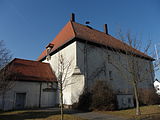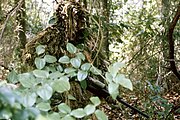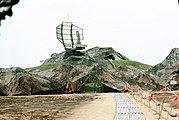Camouflage
![]()
This article deals with the topic in general. For camouflage in animals, see camouflage (biology).
Camouflage is used to change the appearance of an individual or thing so that they can no longer be recognised or can only be recognised with difficulty. This is done, for example, with the help of camouflage clothing with camouflage patterns as well as immobility or lines of movement adapted to the terrain in order to exploit them against visibility also through natural shadowing. In the military, the term camouflage and deception is used in a broader sense.
Camouflage happens through:
Optical camouflage
Camouflage colours, use of terrain, lack of movement, avoidance of standing out from the background and breaking up one's own visual silhouette, among other things, also through jute stripes on the helmet cover or change of shape as with a mitznefet of the Israeli army. In addition, smoke grenades and smoke projectiles are also used for camouflage in order to block the enemy's view of their own forces.
Acoustic camouflage
By avoiding or masking sounds by superimposing them on other, natural sounds.
Odour camouflage
Also olfactory camouflage. Avoid spices, aftershave, cigarette smoke.
Thermal camouflage
Shielding body heat and equipment radiation by using terrain and special clothing or cover. For example, against a thermal imaging device, a very thick plastic sheet helps to shield the body's heat signature.
Especially in the case of larger objects such as warships or combat aircraft, camouflage is not only intended to prevent detection as such, but also to make it more difficult for the enemy to determine their size, type and speed.
In optical camouflage, it is essential to change camouflage depending on the changing background. Thus, in winter, winter camouflage clothing is useful on open, snow-covered terrain, but makes the soldier visible when entering a dark forest. Tufts of green grass in the helmet camouflage cover are useful in a lush meadow, conspicuous in a cornfield ripe for harvesting.
Examples from hunting are North American prairie Indians who wrapped themselves in bison skins when hunting buffalo in order to be able to sneak up on the herds unnoticed. Scottish professional hunters developed the ghillie suit for the open Highlands.
In the military, the term camouflage (French for "misleading, deception, camouflage") is often used. Depending on the prevailing colour of the environment, the soldiers' combat uniforms, for example, are dyed white (in winter) or mottled in earth and olive tones, making them less visible to the enemy. In night combat operations, faces are blackened for the same reason. Larger objects such as tanks or trenches are covered with nets and foliage to prevent possible detection from the air. Multispectral camouflage nets such as the SAAB Barracuda Mobile Camouflage System camouflage in several wavelength ranges, such as infrared (heat radiation), visible light and microwaves (radar). Defence measures against modern tracking techniques such as radar or sonar are called stealth techniques.
In addition to deliberately chosen camouflage, there is also unconsciously chosen camouflage. For example, if a pedestrian dressed in dark clothing moves between the cones of street lights at night, he cannot be recognised by the driver. He is unconsciously in a camouflage zone. Only when he enters the light cone of the street lighting will he be noticed by the car driver.
Camouflage, however, does not always have to involve the usual camouflage colours and blurring of the outline as such. For example, bunkers and fixed gun emplacements can be camouflaged as ordinary houses, which makes them easily and readily recognisable as buildings, but in the vicinity of settlements and towns, or even incorporated into them, they are not conspicuous structures. Similarly, if unauthorised persons are wearing local clothing, e.g. a doctor's coat in a hospital, they are not so easily recognised, even if they are seen doing so.
Camouflage can also be achieved by inconspicuous behaviour (for example as a thief) and by adapting to the movements or sounds of the environment. Computer viruses and cancer cells camouflage themselves in a similar way.
Steganography refers to the camouflage of secret information in a communication, while the carrier of the information, the medium, need not have any further meaning. The security of secret steganographic information lies in the fact that an unauthorised person does not notice its existence or, if he knows about its existence, he cannot recognise it.
Camouflaging or concealing is when politicians, for example, suppress true facts in speeches or top managers of large companies present the economic situation of their company in a positive light, although this is not true.
· 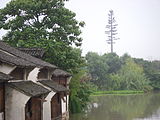
Camouflaged mobile phone transmitter near the museum village Wuzhen Xizha in China
·
Chimney mock-ups on a high bunker in Fürth serve to cover mobile phone antennas
· 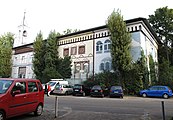
Air raid shelter disguised as a church Church bunker Deutz, World War II
· 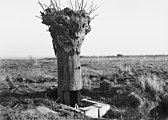
The mock-up of a tree is used as an observation post during the battle of Messines on Hill 63 (Belgium, 7 June 1917)
· 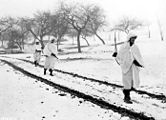
American soldiers with snow camouflage improvised from white sheets during the German Battle of the Bulge (1944)
·
Sniper in US Marines ghillie suit
· 
Covered embrasure of the Swiss fortress Reuenthal
· 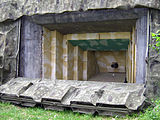
Open embrasure of the Swiss fortress Reuenthal
· 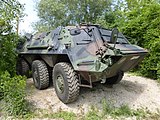
Bundeswehr Fuchs transport tank with three-colour camouflage paint scheme
· 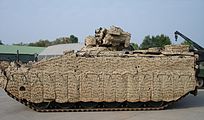
Marder 1A5 infantry fighting vehicle with Barracuda camouflage system from Saab
· 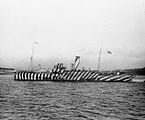
Royal Navy warship with camouflage painting
· .jpg)
F/A-18 of the Canadian Air Force. The cockpit canopy painted on the underside is intended to deceive the enemy about the actual flight attitude of the aircraft in air combat
·
Radar AN/TPS-43 with camouflage nets
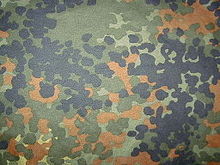
German Armed Forces camouflage pattern
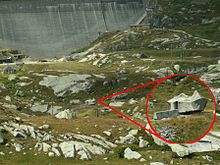
Camouflage of stationary equipment (tank turret of the San Carlo artillery plant) by recording structures of the surroundings

Camouflage through camouflage clothing in the military

Camouflage aircraft by adjusting the background
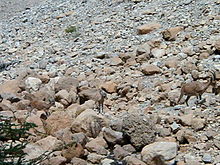
Camouflage in nature
See also
- Mimicry
- Optical illusion
- Stealth
- Camouflage clothing
- Camouflage pattern
- Camouflage net
- Camouflage make-up
- Invisibility
- The wolf as shepherd
Questions and Answers
Q: What is camouflage?
A: Camouflage is a way for animals to blend in with their surroundings visually in order to avoid being recognized easily.
Q: Why is it important for animals to use camouflage?
A: Camouflage helps protect animals from predators by making it difficult for them to be seen.
Q: What is an example of camouflage?
A: An example of camouflage is a tiger's stripes in the long grass, which help it blend in with its environment and avoid being seen by prey or predators.
Q: What is the meaning of the word camouflage?
A: The word camouflage comes from the French word camoufler, which means "to disguise."
Q: Is camouflage a form of deception?
A: Yes, camouflage is a form of deception as it helps animals to hide from predators or prey by changing their visual appearance.
Q: Can only animals use camouflage?
A: No, humans also use camouflage in various ways, such as in military operations, hunting, and even in fashion.
Q: How does camouflage benefit animals?
A: Camouflage benefits animals by helping them stay hidden from predators and prey, allowing them to hunt or forage more effectively, avoid being spotted, and increase their chances of survival.
Search within the encyclopedia
